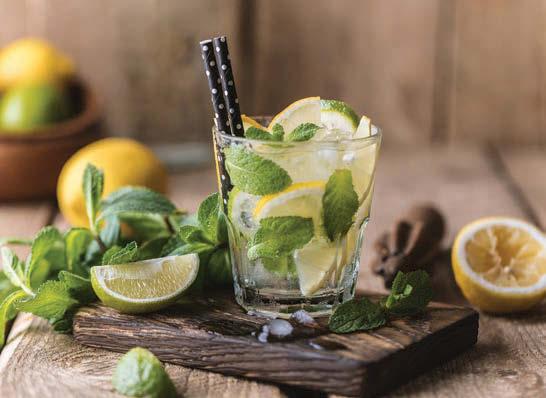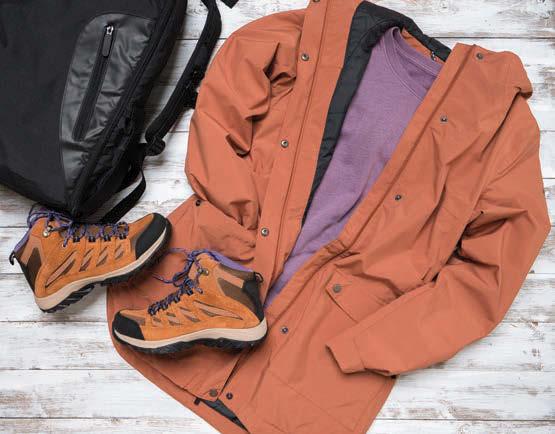
17 minute read
Health Benefts of Lemons and Limes
It makes sense to discuss the health benefts of lemons and limes at the same time, as they have all but a few chemicals in common. Tey are delicious, refreshing fruits that taste great in water or when added to certain dishes. As it turns out, they are also great for your body. Here are twelve diferent ways in which eating lemons and limes might improve and extend your life. Tey are good for the digestive system: Lemon and lime juice behave in a similar way to our natural digestive enzymes, which means that they can help us digest our food as well as relieve us from uncomfortable wind and bloating. Try adding lemon or lime juice to a warm glass of water when you have heartburn or indigestion. Tey protect against cancer:
Lemons and limes contain compounds called limonins, which research shows can help to fght cancers of the mouth, skin, lungs, breast and stomach. Tere is also a connection between limonins and fghting colorectal cancers. In one important study, it was revealed that limonins were still present in the blood of subjects even afer 24 hours had passed. It is thought that this persistence in the body helps to explain why limonins can be a powerful ally in the fght against cancer (as most other anti-carcinogens are available to the body for just a few hours). Te kaempferol in lemons and limes has also been shown to reduce the uncontrolled cell division that is characteristic of cancer (and this element of lemons and limes appears to have a particularly strong infuence on breast cancer). thought that this fascinating health beneft comes from favonoids called favonol glycosides. Tey are good for cardiovascular health:
Advertisement
Vitamin C can help to protect the body against free radicals, which are capable of making cholesterol dangerously more likely to build up and line the walls of your arteries. Lemons and limes happen to contain a lot of vitamin C, so they will make you less likely to develop heart disease or diabetes (or slow the progression of either disease if you already sufer from it). Tey can help tired feet:
If your feet are aching and tired afer a long day of walking or working, try mixing lemon juice with warm water to create a relaxing and refreshing bath for your feet. You can also try slicing a lemon or lime in half and then rubbing the slice against the sorest areas of your feet. Tey help to protect against arthritis:
Free radicals that fnd their way into the body can also end up causing painful infammation. Since vitamin C helps to fght these free radicals, eating lemons and limes may help to reduce infammation in arthritic people (whether that arthritis is rheumatoid or osteoarthritis). Some studies also suggest that those who eat the least vitamin C are most likely to develop some form of arthritis, so if you don’t have arthritis then it is worth eating plenty of lemons and limes (among other fruits rich in vitamin C) to help guard against the development of arthritis. Surprising Health Benefts of Lemons and Limes
Tey have antibiotic and antiseptic properties:
Given that lemons and limes are very acidic, this makes them ideal for fghting certain infections. During a cholera epidemic in West Africa, it was discovered that drinking lime juice appeared to protect citizens against contracting cholera bacteria. Further studies supported that lime juice did indeed play a role in whether people would contract cholera. It is
Lemon juice can help to prevent (and get rid of) kidney stones: Te American Urological Association has conducted research that proves lemon juice is capable of breaking down or preventing kidney stones. Tis is because lemon juice leads to the production of urinary citrate, which in turn prevents the formation of crystals.
Tey can help with weight loss:
Lemons and limes contain no fat, no cholesterol, and around a mere twenty calories each. Tis makes them an ideal fruit to snack on (if you like sour treats), and also ideal to include as part of a meal while dieting. Further, adding lemon or lime to water can help to discourage you from drinking sodas that contain huge amounts of sugar and calories.
Tey help maintain healthy blood pressure:
It has been speculated that the potassium in lemons and limes can help to keep your blood pressure within healthy limits.
















































































































Lemon juice is great for your hair:
Many people are aware of how hair can beneft from lemon juice. It can help to treat scalp problems such as dandruf, and it also makes your hair brighter (as well as shinier).
Tey help to strengthen your immune system:
Te vitamin C in lemons and limes also aids in developing a stronger immune system. Tis means that lemons and limes will help prevent you from falling ill as a result of viral and bacterial infections.
Tey are good for respiratory health:
It is thought that lemons and limes can help to treat some of the respiratory symptoms that develop during cold or fu infections (such as persistent coughing and a sore throat). Tere is some speculation that they might also help to treat asthma, but this is contentious and requires substantial further research.
As is obvious from the above health benefts, lemons and limes are an excellent choice if you want to increase your daily intake of fruits and vegetables. You can incorporate them into your diet in a number of enjoyable ways. For example, try slicing them and placing them on top of fsh before baking, or squeeze lemon and lime juice into salsa. Ee
The Spice & Tea Exchange ® of Asheville
46 Haywood St., #101 Asheville, NC 28801 (828) 505-7348
As this season of winter comes to an end, I fnd myself yearning to go outside and wander among budding wildfowers, to hike up mountain trails, and to explore new paths. Hiking is defned as walking in the countryside for pleasure or sport, and it’s one of the healthiest hobbies I can think of. It’s also one of the world’s most popular pasttimes. One reason is that aside from a good, supportive pair of shoes, there is little gear needed for a day in the woods. At least that’s what I thought until I began research for this article. Hiking has become big business. Gone are the days of throwing on a t-shirt and pair of jeans; there is now an entire industry dedicated to hiking wear. Since I love clothes and dressing for every occasion, I give serious thought to what to wear: What does a fashion girl wear while stomping through the woods? Turns out, there is a lot to learn and consider. Is it going to rain? How do I protect myself from the sun, brush, and bugs? Will it be cold? Or hot? Do I have to sacrifce style for function? Fortunately, rugged, woodsy hiking clothes don’t have to be unattractive. You can integrate your personal style with protective, warm, comfortable clothing and look great on the trail. Afer all, who wants to spend a day looking at the beauty of nature dressed recklessly or sloppily? Te most important factor to consider when choosing what to purchase—and wear— is the fabric used to create the garment. It is recommended to avoid cotton in tops, pants, and socks. Cotton fbers will absorb moisture— perspiration and raindrops—and hold onto it all day. Hiking in wet clothes can turn a pleasurable day into a miserable day. It can also be dangerous if you get cold, wet, and are unable to dry out. Look for breathable fbers that wick moisture away. Merino wool is considered to be a “wonder fabric” by many seasoned hikers. It helps to keep you warm when it’s cold and cool when it’s hot. Quick-drying synthetic fbers include polyester, nylon, spandex, and elastane. Also look for clothing made with fabrics that don’t rip easily and that have a little stretch for those long strides. Some fabrics have built-in sun-protector and insect-repellent properties. High-quality hiking clothes are designed with specifc hiking activities in mind; therefore the cut and fabrics complement the sport. Form follows function. :)
When planning your hiking outft, the primary consideration is how to be comfortable and stay dry throughout the day. Checking out the weather forecast will help you determine what to wear. So, let’s start at the top. On cold winter days, wearing something on your head is essential. Wearing a tightly-knit beanie or insulated hat can make your hiking experience much more enjoyable than being exposed to the elements. During the summer, a brimmed-hat will protect your face from sun exposure. Hats also protect your head from low-lying brush and tree limbs. Wrapping a scarf around your neck can make you more comfortable on a chilly day. You can keep it there or move it up to your face if the chill is especially chilling. Safeguard your eyes with sunglasses—no matter the season.
On hikes where the elevation changes, you may begin at a comfortable 60 degrees and end up with a temperature of Taylor’d with Style High-Fashion Hiking By JeanAnn Taylor

20-something when you reach the mountain peak. Te key to comfort is layering. First, put on a long-sleeve t-shirt and add from there. Depending on the weather, a lightweight jacket or polyester feece hoodie may be all you need. On cold days, a down jacket will ofer warmth and is easily packable if you don’t need it all day. A windbreaker can block the breeze but doesn’t ofer much insulation or warmth. A waterproof shell is designed to carry perspiration away from your body while also keeping precipitation from entering in. I prefer a light-weight, long-sleeve t-shirt even on warm, sunny, summer days. Te sleeves help protect my arms from brush, sun, and insects.

Next on the list: pants. Until recently, I have always worn bluejeans for hiking. Te rugged and durable denim fabric seemed perfect for a day of climbing rocks and walking through paths of overgrown brush. Now, there are pants made from tough, light-weight, non-cotton materials. Many pant options have stretchy-spandex integrated into the fabric to make rock climbing and sitting cross-legged on the ground more comfortable. Hiking pants also have pockets strategically placed for hiking essentials. Some pant styles are convertible— they can be unzipped at the thigh to transform into shorts.
Don’t forget the little things: socks and undies can make a big diference in the overall comfort of your day. To avoid blisters, it may help to wear two pairs of socks; a thick pair over a thin pair. Termal underwear or a pair of tights can keep you warm on cold days, and gloves are handy for keeping your fngers from freezing. Ladies need to wear a supportive bra that doesn’t bind or shif around.
Finally: footwear. Whether you prefer high or low tops, a pair of supportive, waterproof hiking boots is the most essential article of gear you need. If your feet hurt, you will spend the entire day in agony. I prefer high tops as they ofer more ankle support and protection from thorns and snakes. Te only way to know which footwear is best for you is to try several pairs on and decide for yourself.
Hiking clothes can be stylish and fun, which makes the whole experience more enjoyable. Afer all, if you are going to hike, you might as well look cute. Ee
(Tanks to Catherine Love and Linda James for their helpful hiking information)

Style expert JeanAnn Taylor jeananntaylor@rewnc.com What to Bring Being prepared is vital to a successful and delightful day in the woods. What to pack in your backpack: enough to get you through the day, but not so much that your pack becomes too heavy. Here is a list of my hiking essentials:
* Plenty of water—in a non-glass container. * Food to sustain you: nuts, fruit, chocolate. * An extra pair of socks in case one pair gets wet. * Lip balm, hand sanitizer or wipes, and lotion. (See Taylor’d with Style January 2020) * A bandana. * First aid supplies. * A sitting pad. * A rain jacket or poncho. * Trash bag—Don’t leave anything behind except your footprints. * Jingle bells. Don’t laugh. There are times on the trail when everyone is quiet; lost in their own thoughts and mesmerized by the beauty of nature. To avoid sneaking up on Mama bear, I wear a jingle bell tied onto my shoelace to alert her of my presence. The soft jingle isn’t annoying, and it keeps Mama bear from being startled.
It’s also recommended to bring a change of clothes to keep in the car—just in case you get wet and don’t want to ride home in soaking clothes. If you have hiking tips, I’d love to hear them. Please send an email to me: jeananntaylor@rewnc.com









